Quantitative Analysis and Evaluation of Coal Mine Geological Structures Based on Fractal Theory
Abstract
1. Introduction
2. Study Area
3. Fractal Evaluation of the Fault Network Complexity
3.1. Fractal Theory
3.2. Determination of the Fold Fractal Dimension
3.2.1. Calculation of the Fractal Dimension of Folds in the Fan Gezhuang Mine
3.2.2. Calculation of the Fractal Dimension of Folds in the Qian Jiaying Mine
3.2.3. Calculation of the Fractal Dimension of Folds in the Lin Xi Mine
3.2.4. Calculation of the Fractal Dimension of Folds in the Lv Jiatuo Mine
3.3. Determination of the Fault Fractal Dimension
3.3.1. Calculation of the Fractal Dimension of Faults in the Fan Gezhuang Mine
3.3.2. Calculation of the Fractal Dimension of Faults in the Qian Jiaying Mine
3.3.3. Calculation of the Fractal Dimension of Faults in the Lin Xi Mine
3.3.4. Calculation of the Fractal Dimension of Faults in the Lv Jiatuo Mine
4. Analysis of the Mathematical Geology
5. Conclusions
- (1)
- The value of the fold fractal dimension of the Fan Gezhuang mine is 1.44, and this value is very high, which indicates the geological structures in the mine area is complicated. The fractal dimension of each partitioned unit is mainly between 0.97 and 1.23, and the obtained results on the structural complexity of the region reveal a high heterogeneity. The value of the fault fractal dimension is 1.5766, and the fractal dimension is between 1.00 and 1.96 in most partitioned units and is higher than 0.8 everywhere. Many uniformly distributed faults are concentrated in the Ta Tuo syncline area, and most faults are well-developed extensional normal faults.
- (2)
- The fold fractal dimension value in the Qian Jiaying mine is 0.9391. The fractal dimension of the majority of the partitioned units is less than 0.71, which shows the fractal dimension of the many uniformly distributed folds is high in the northeast, low in the middle, and high in the southwest. The fault fractal dimension is 1.4544, and the fractal dimension of most partitioned units is between 0.9 and 1.96, with most being higher than 0.9, which reveals a wide range. Many faults are uniformly distributed in the northeastern region, and most faults are well-developed extensional normal faults.
- (3)
- Three extremely thick residual contour areas occur in the northeast of the No. 9 coal seam floor. The fold structure in the region is represented by the distribution of the zero line. The extension direction of the zero line of the fold in the southwestern region accurately reflects the position of the fold axes in the structure division. The synthesized diagram of the fold and fault fractal dimensions in the Qian Jiaying and Fan Gezhuang mines is consistent with the distribution of the fold and fault fractal dimensions in the northeast of the Qian Jiaying mine. This method can be applied to quantify various indexes including the number, scale, development degree, and combination manner.
Author Contributions
Funding
Institutional Review Board Statement
Informed Consent Statement
Data Availability Statement
Conflicts of Interest
References
- Koukouvelas, I.K.; Asimakopoulos, M.; Doutsos, T.T. Fractal characteristics of active normal faults: An example of the eastern Gulf of Corinth, Greece. Tectonophysics 1999, 308, 263–274. [Google Scholar] [CrossRef]
- Zhang, R.; Jiang, Z.; Zhou, H.; Yang, C.; Xiao, S. Groundwater outbursts from faults above a confined aquifer in the coal mining. Nat. Hazards 2013, 71, 1861–1872. [Google Scholar] [CrossRef]
- Li, R.; Wang, Q.; Wang, X.; Liu, X.; Li, J.; Zhang, Y. Relationship Analysis of the Degree of Fault Complexity and the Water Irruption Rate, Based on Fractal Theory. Mine Water Environ. 2017, 36, 18–23. [Google Scholar] [CrossRef]
- Adinehvand, R.; Raeisi, E. Characterization of a karst aquifer in a complex tectonic region, Southwestern Iran. J. Cave Karst Stud. 2018, 80, 190–205. [Google Scholar] [CrossRef]
- Rainaud, J.F.; Clochard, V.; Dele′pine, N.; Crabie, T.; Poudret, M.; Perrin, M.; Klein, E. Building a 3D faulted a priori model for stratigraphic inversion: Illustration of a new methodology applied on a North Sea field case study. J. Appl. Geophys. 2018, 154, 128–135. [Google Scholar] [CrossRef]
- Schwartz, V.B.; Orndorff, W. Hydrogeology of the Mississippian Scarp-Slope Karst System, Powell Mountain. J. Cave Karst Stud. 2009, 71, 168–179. [Google Scholar] [CrossRef]
- Li, H.; Bai, H.; Wu, J.; Ma, Z.; Ma, K.; Wu, J.; Du, Y.; He, S. A Cascade Disaster Caused by Geological and Coupled Hy-dro-Mechanical Factors-Water Inrush Mechanism from Karst Collapse Column under Confining Pressure. Energies 2017, 10, 1938. [Google Scholar] [CrossRef]
- Foudili, D.; Bouzid, A.; Berguig, M.C.; Bougchiche, S.S.; Abtout, A.; Guemache, M.A. Investigating karst collapse geo-hazards using magnetotellurics: A case study of M’rara basin, Algerian Sahara. J. Appl. Geophys. 2019, 160, 144–156. [Google Scholar] [CrossRef]
- Yin, S.; Zhang, X.; Xu, H.; Liu, M.; Xu, B. Optimization of permeability coefficient and aquifer thickness in large-well-method. Coal Geol. Explor. 2015, 43, 53–56. (In Chinese) [Google Scholar]
- Mehaute, A.L. Fractal Geometries Theory and Applications; CRC Press: Boca Raton, FL, USA, 1991; p. 181. [Google Scholar]
- Liucci, L.; Melelli, L. The fractal properties of topography as controlled by the interactions of tectonic, lithological, and geomorphological processes. Earth Surf. Process. Landforms 2017, 42, 2585–2598. [Google Scholar] [CrossRef]
- Haddad-Martim, P.M.; Carranza, E.J.M.; Roberto, C.; Filho, D.S. The fractal nature of structural controls on ore formation: The Case of the Iron oxide copper-gold deposits in the carajás mineral province, Brazilian amazon. Econ. Geol. 2018, 113, 1499–1524. [Google Scholar] [CrossRef]
- Liu, Y.; Zhu, L.; Ma, S.; Guo, F.; Gong, Q.; Tang, S.; Gopalakrishnan, G.; Zhou, Y. Constraining the distribution of elements and their controlling factors in the Zhaojikou Pb–Zn ore deposit, SE China, via fractal and compositional data analysis. Appl. Geochem. 2019, 108, 104379. [Google Scholar] [CrossRef]
- Simonov, D.A.; Zakharov, V.S.; Bryantseva, G.V. Complex Geomorphological, Morphological, and Fractal Analysis of the Most Recent Vertical Tectonic Movements of the Kerch Peninsula. Mosc. Univ. Geol. Bull. 2019, 74, 549–558. [Google Scholar] [CrossRef]
- Yu, Q.; Dai, Z.; Zhang, Z.; Soltanian, M.R.; Yin, S. Estimation of Sandstone Permeability with SEM Images Based on Fractal Theory. Transp. Porous Media 2019, 126, 701–712. [Google Scholar] [CrossRef]
- Dong, S.; Xu, L.; Dai, Z.; Xu, B.; Yu, Q.; Yin, S.; Zhang, X.; Zhang, C.; Zang, X.; Zhou, X.; et al. A Novel Fractal Model for Estimating Permeability in Low-Permeable Sandstone Reservoirs. Fractals 2020, 28, 2040005. [Google Scholar] [CrossRef]
- Yu, Q.; Xiong, Z.; Du, C.; Dai, Z.; Soltanian, M.R.; Soltanian, M.; Yin, S.; Liu, W.; Liu, C.; Wang, C.; et al. Identification of rock pore structures and permeabilities using electron microscopy experiments and deep learning interpretations. Fuel 2020, 268, 117416. [Google Scholar] [CrossRef]
- Zhou, S.-G.; Zhou, K.-F.; Wang, J.-L. Geochemical metallogenic potential based on cluster analysis: A new method to extract valuable information for mineral exploration from geochemical data. Appl. Geochem. 2020, 122, 104748. [Google Scholar] [CrossRef]
- Mandelbrot, B. How Long Is the Coast of Britain? Statistical Self-Similarity and Fractional Dimension. Science 1967, 156, 636–638. [Google Scholar] [CrossRef]
- Fan, C.; Qin, Q.; Hu, D.; Wang, X.; Zhu, M.; Huang, W.; Li, Y.; Ashraf, M.A. Fractal characteristics of reservoir structural fracture: A case study of Xujiahe Formation in central Yuanba area, Sichuan Basin. Earth Sci. Res. J. 2018, 22, 113–118. [Google Scholar] [CrossRef]
- Stanton-Yonge, A.; Cembrano, J.; Griffith, W.; Jensen, E.; Mitchell, T. Self-similar length-displacement scaling achieved by scale-dependent growth processes: Evidence from the Atacama Fault System. J. Struct. Geol. 2020, 133, 103993. [Google Scholar] [CrossRef]
- Scholz, C.H.; Aviles, C.A. Fractal dimension of the 1906 San Andreas fault and 1915 Pleasant Valley faults. Earthq. Notes 1985, 55, 20. [Google Scholar]
- Barton, C.C.; Hsieh, P.A. Physical and hydrologic flow properties of fractures. In Proceedings of the 28th International Geological Congress Field Trip Guidebook T385, Geophysical Union, Washington, DC, USA, 9–19 July 1989. [Google Scholar]
- Shi, L.; Liu, L.; Zhou, J.; Xing, T.; Niu, C.; Wang, Y. Fault Fractal Information Dimension and Its Application in Floor Water Burst. Coal Ming Technol. 2014, 19, 12–16. (In Chinese) [Google Scholar]
- Li, X.; Wang, Q.; Hong, Y.; Yan, H.; Liu, D. Tectonics Control on Coal Measures in Donghuantuo Coalmine, Kailuan Mining Area. Coal Geol. China 2008, 20, 42–44. (In Chinese) [Google Scholar]
- Mandelbrot, B.B.; Wheeler, J.A. The Fractal Geometry of Nature. Am. J. Phys. 1983, 51, 286–287. [Google Scholar] [CrossRef]
- Adler, P.M.; Thovert, J.-F. Fractal porous media. Transp. Porous Media 1993, 13, 41–78. [Google Scholar] [CrossRef]
- Gao, M.; Ji, P.; Miao, Z.; Wan, K.; He, Q.; Xue, S.; Pei, Z. Pore structure evolution and fractal characteristics of Zhaotong lignite during drying. Fuel 2020, 267, 117309. [Google Scholar] [CrossRef]
- Rostamzadeh, H.; Salimi, M.R.; Taeibi-Rahni, M. Pore-scale modeling of rarefied gas flow in fractal micro-porous media, using lattice Boltzmann method (LBM). J. Therm. Anal. Calorim. 2018, 135, 1931–1942. [Google Scholar] [CrossRef]
- Karimpouli, S.; Tahmasebi, P. 3D multi-fractal analysis of porous media using 3D digital images: Considerations for heter-ogeneity evaluation. Geophys. Prospect. 2019, 67, 1082–1093. [Google Scholar] [CrossRef]
- Xia, Y.; Cai, J.; Wei, W.; Hu, X.; Wang, X.; Ge, X. A New Method for Calculating Fractal Dimensions of Porous Media Based on Pore Size Distribution. Fractals 2018, 26, 26. [Google Scholar] [CrossRef]
- Foroutan-pour, K.; Dutilleul, P.; Smith, D.J. Advances in the implementation of the box-counting method of fractal di-mension estimation. Appl. Math. Comput. 1999, 105, 195–210. [Google Scholar]
- Matsumoto, N.; Yomogida, K.; Honda, S. Fractal analysis of fault systems in Japan and the Philippines. Geophys. Res. Lett. 1992, 19, 357–360. [Google Scholar] [CrossRef]
- Dimitrakopoulos, R.; Scott, J.; Li, S. Multi-fractal conditional simulation of fault populations in coal seams using analogues: Method and application. Int. J. Mining Reclam. Environ. 2018, 33, 340–352. [Google Scholar] [CrossRef]
- Yang, B.; Yuan, J.; Duan, L.; Liu, Q. Using GIS and Fractal Theory to Evaluate Degree of Fault Complexity and Water Yield. Mine Water Environ. 2018, 38, 261–267. [Google Scholar] [CrossRef]


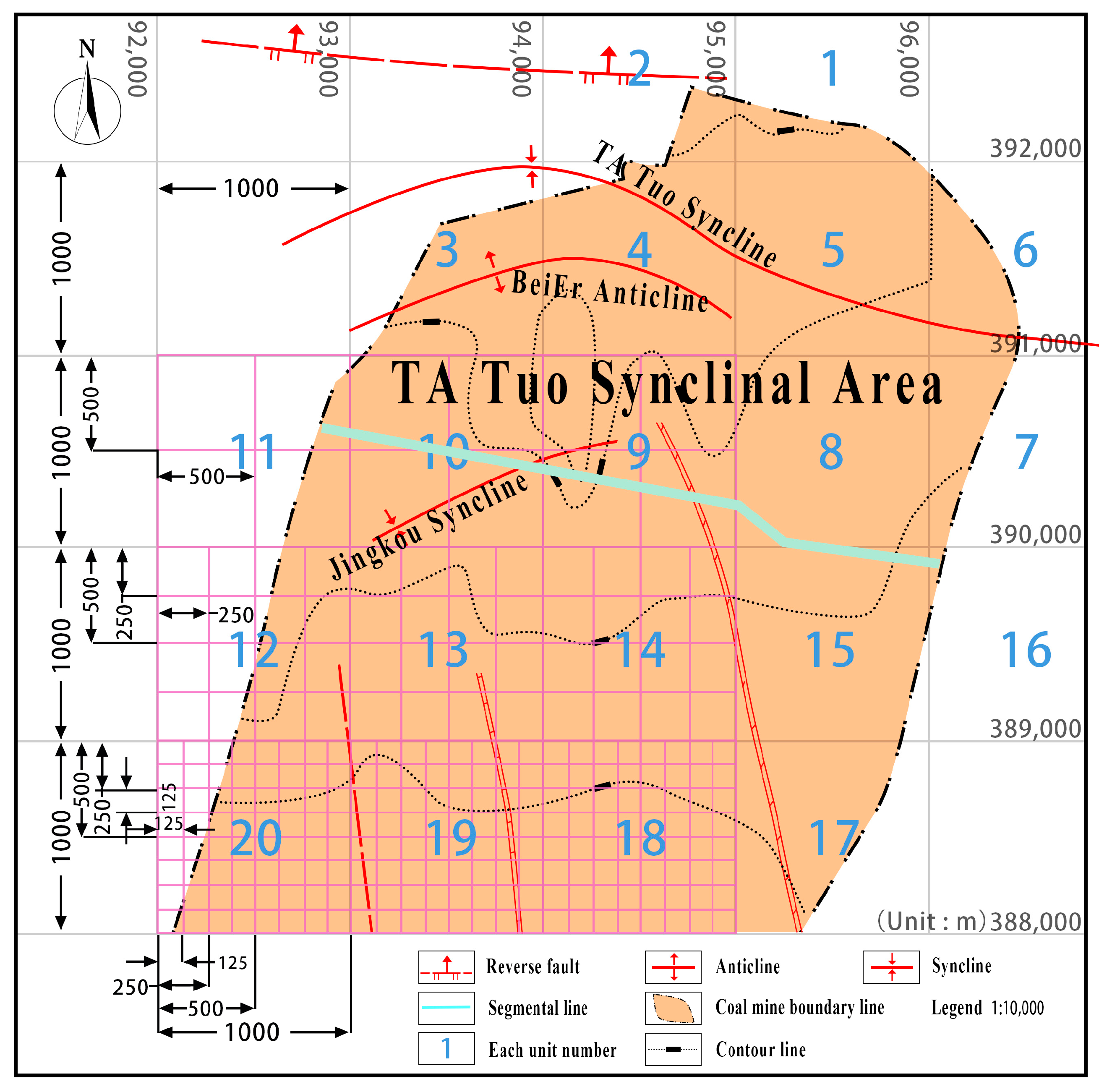
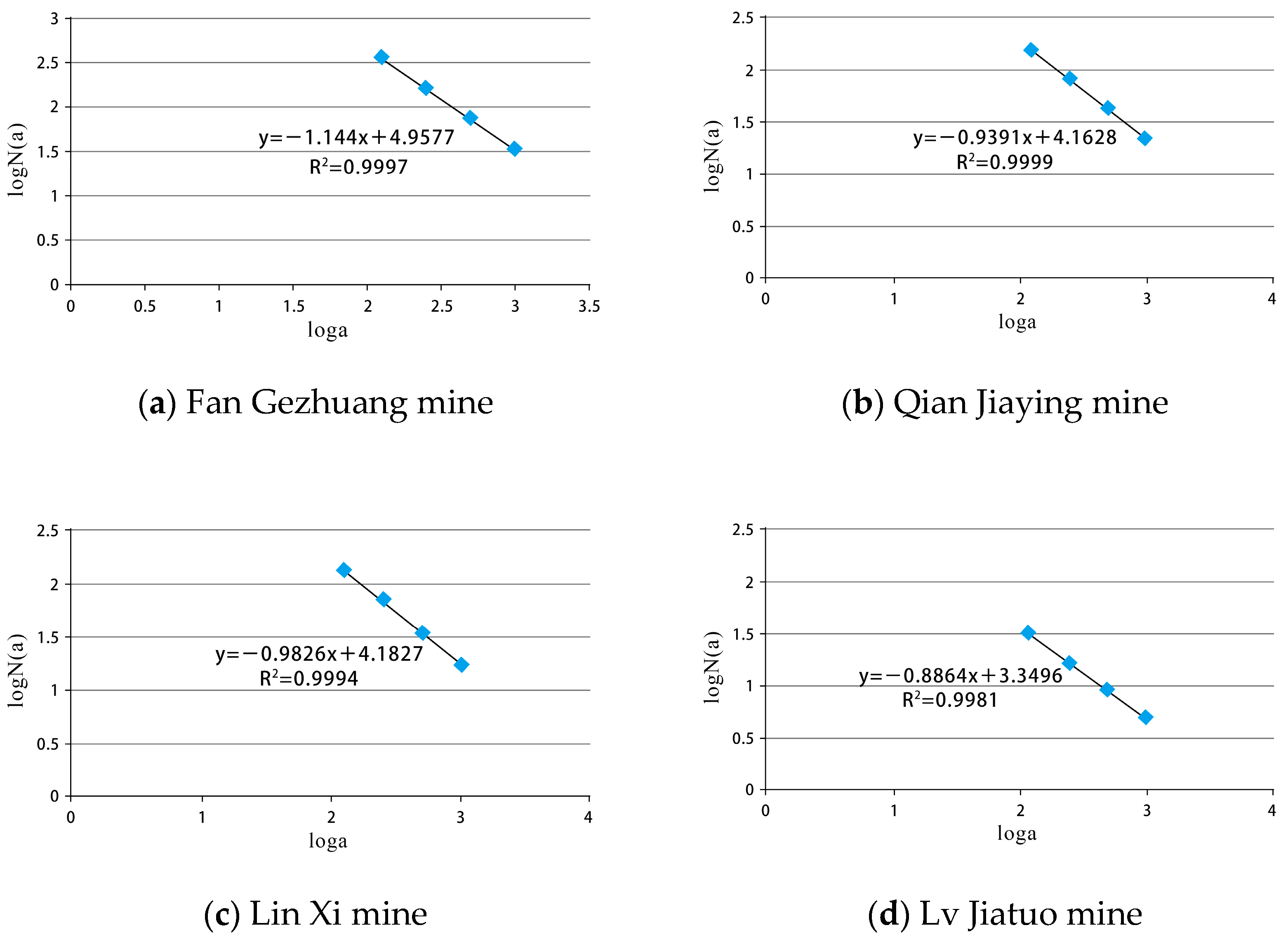
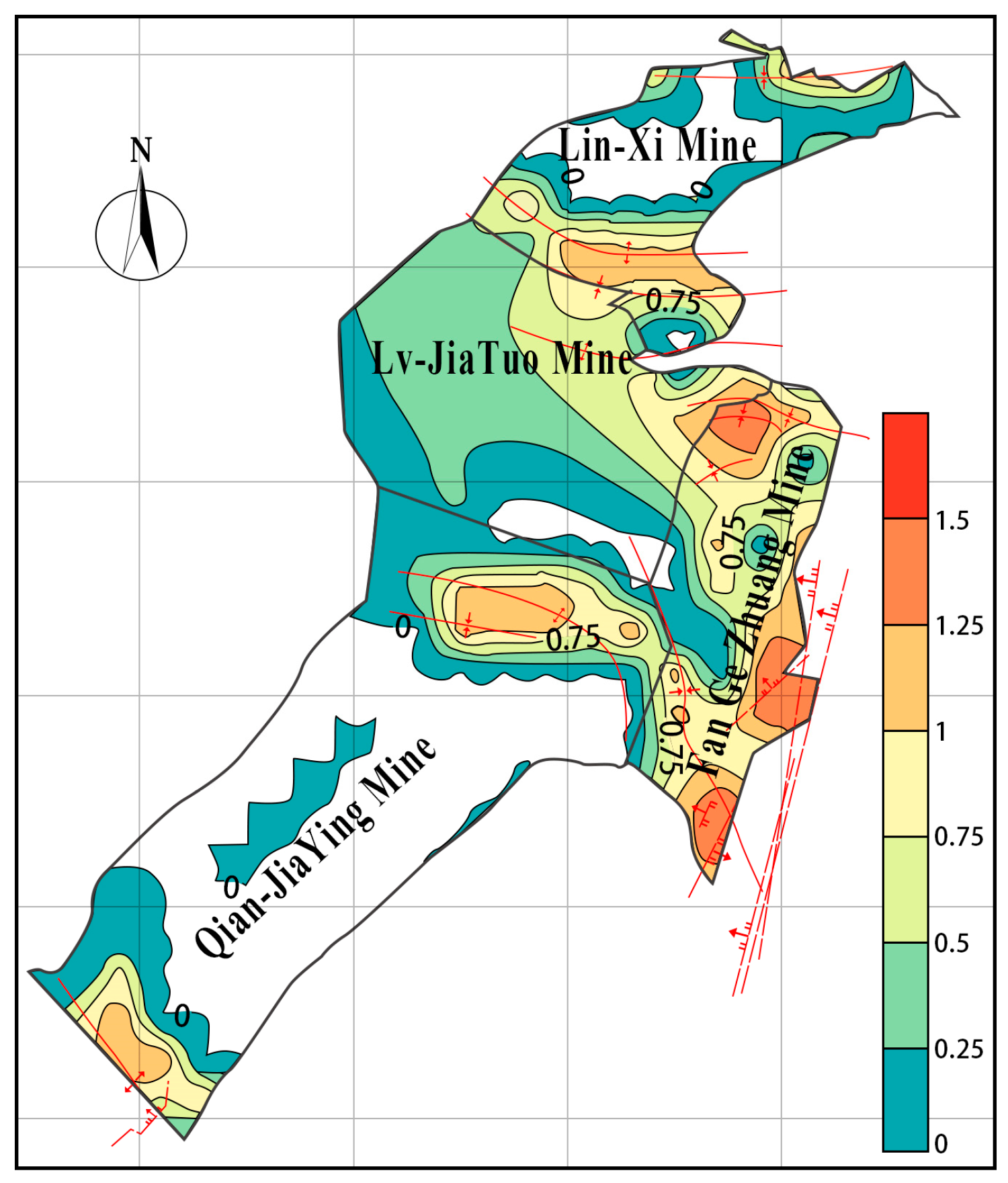
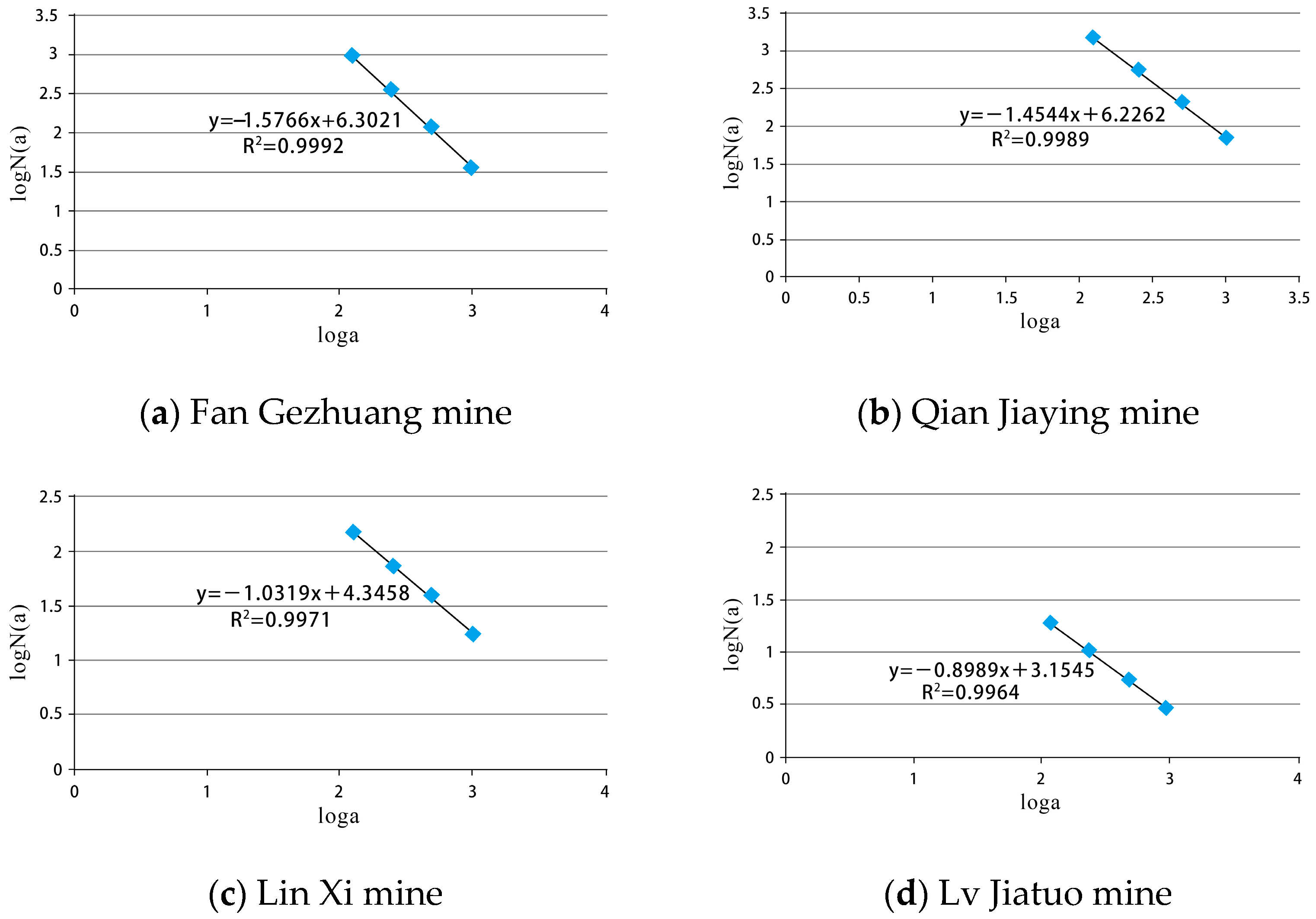
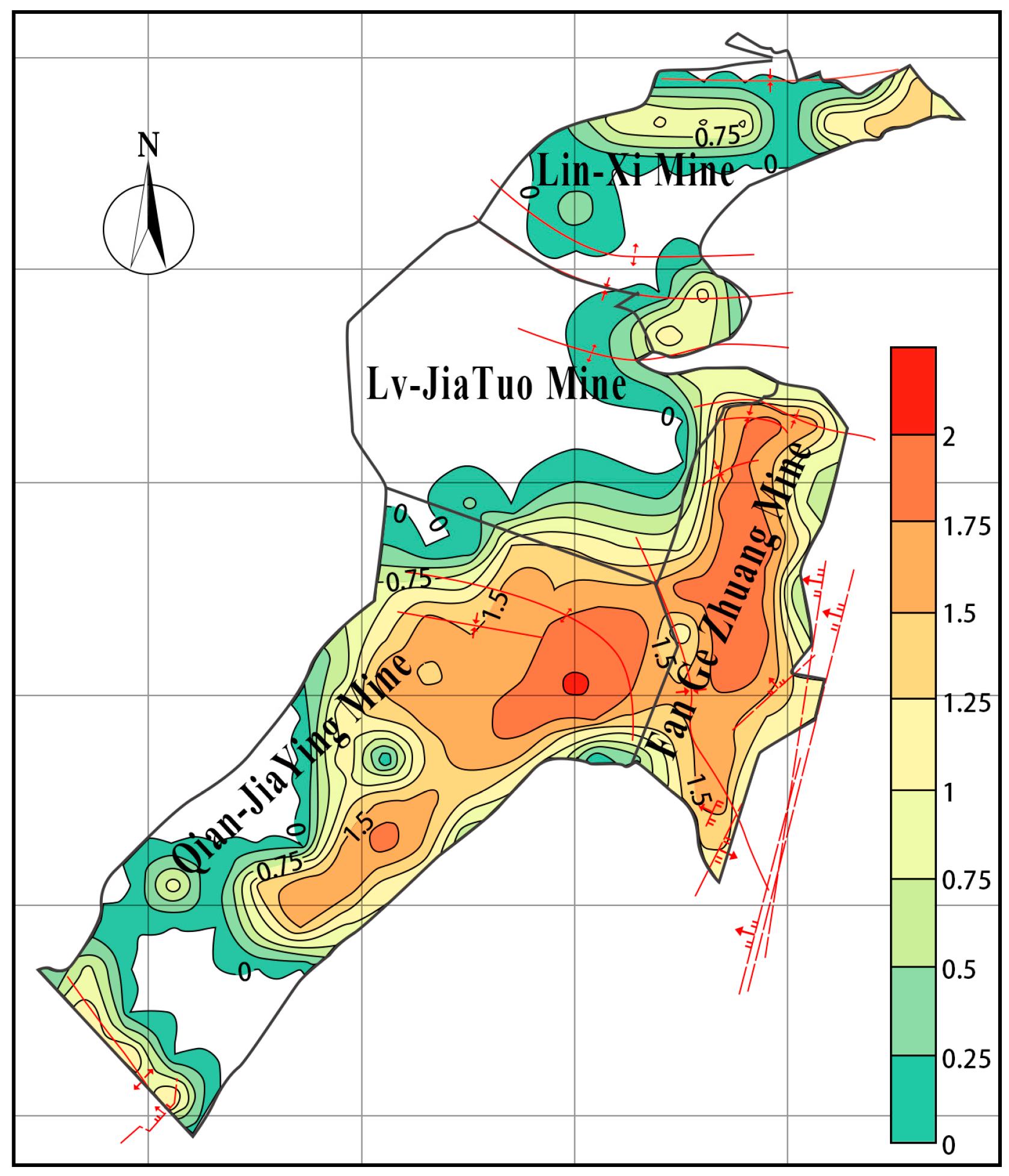
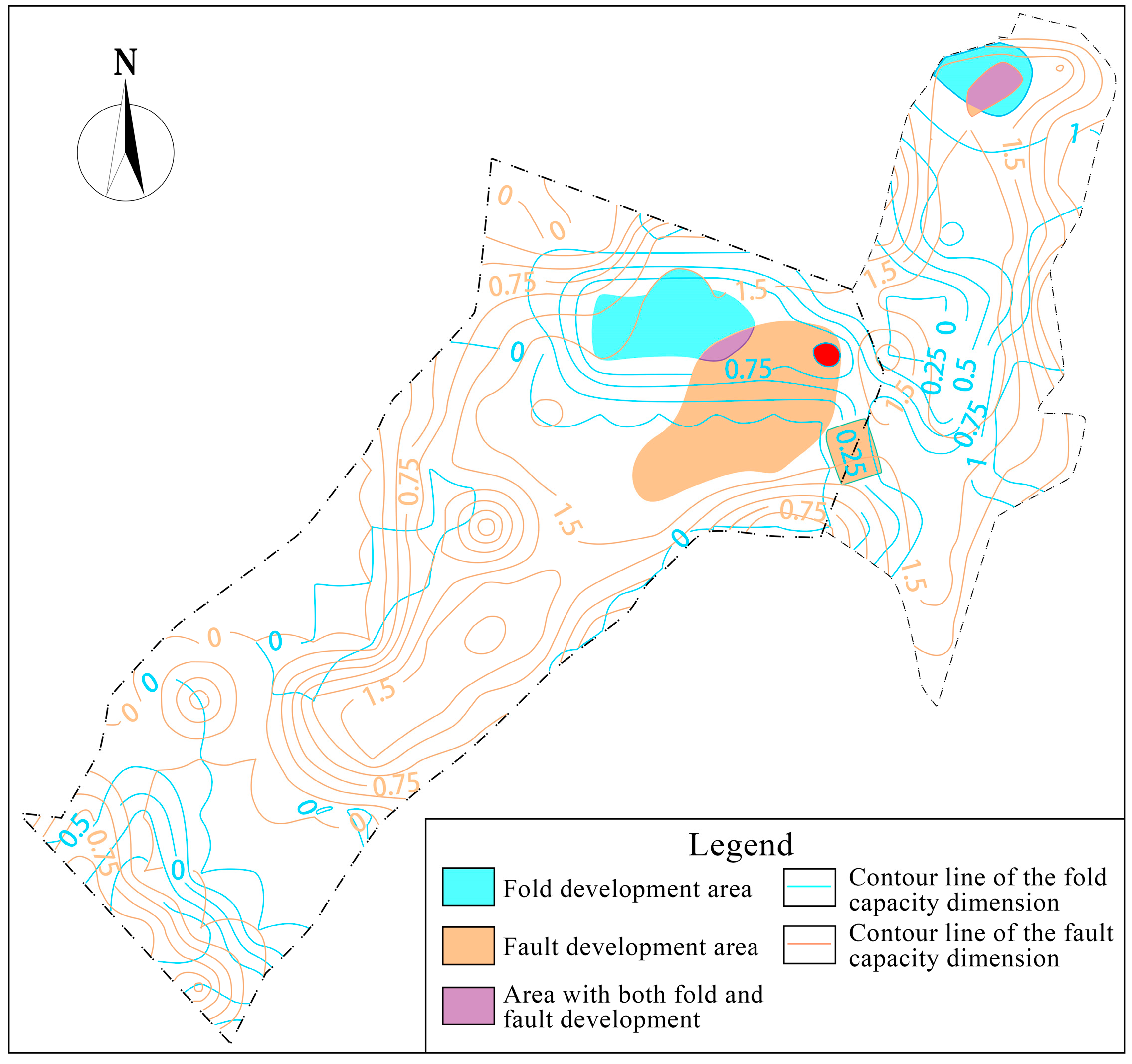
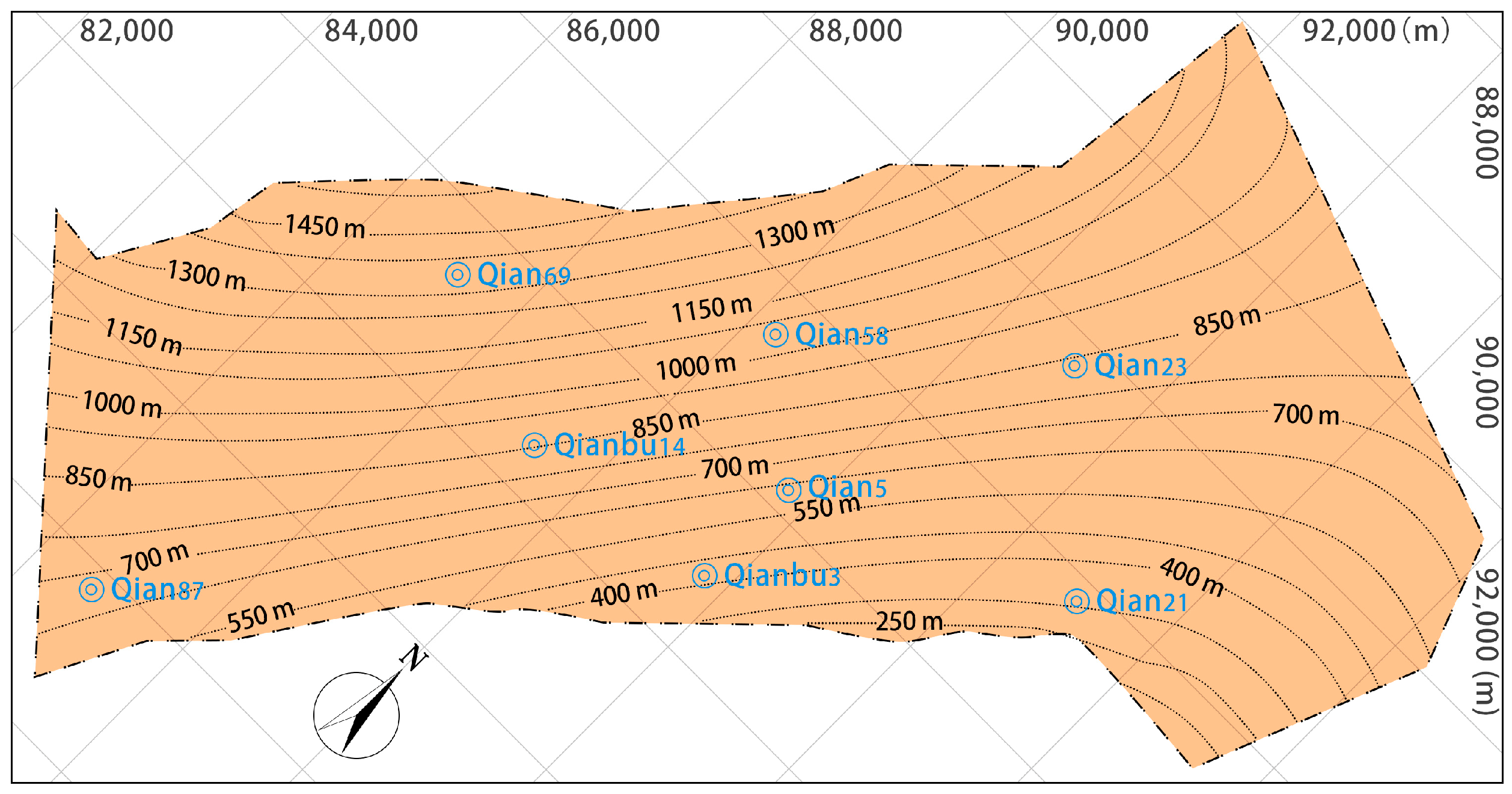
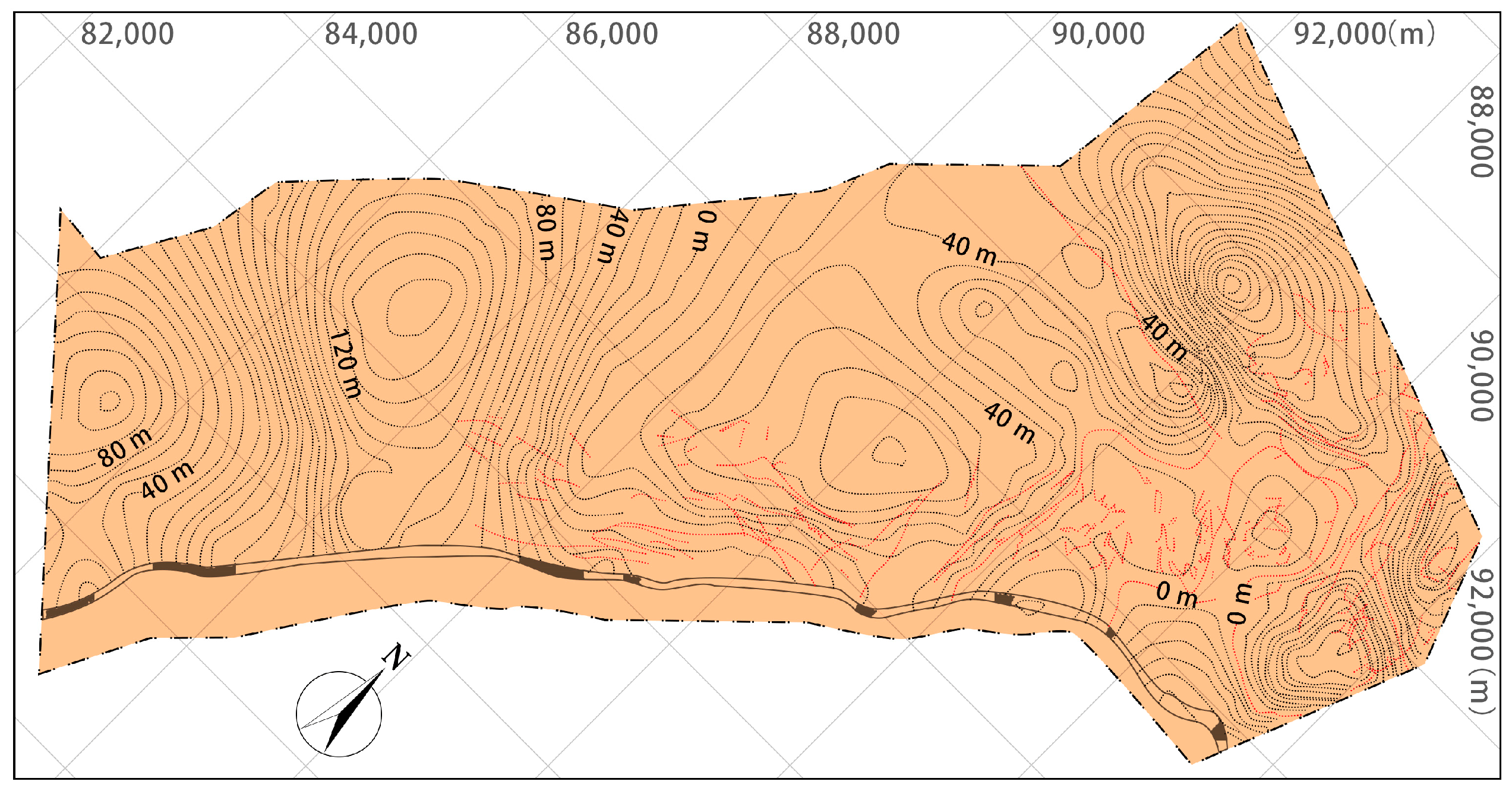
| Number | Area | Regression Equation | Fractal Dimension D | Correlation Coefficient R2 |
|---|---|---|---|---|
| 1 | Whole mine | y = −1.144x + 4.9577 | 1.144 | 0.9967 |
| 2 | TaTuo syncline | y = −1.199x + 4.492 | 1.199 | 0.9875 |
| 3 | Monoclinal structure | y = −0.9783x + 3.9978 | 0.978 | 0.9974 |
| 4 | Bi Gezhuang Syncline | y = −1.227x + 4.8295 | 1.227 | 0.9881 |
Publisher’s Note: MDPI stays neutral with regard to jurisdictional claims in published maps and institutional affiliations. |
© 2021 by the authors. Licensee MDPI, Basel, Switzerland. This article is an open access article distributed under the terms and conditions of the Creative Commons Attribution (CC BY) license (https://creativecommons.org/licenses/by/4.0/).
Share and Cite
Zhang, G.; Guo, J.; Xu, B.; Xu, L.; Dai, Z.; Yin, S.; Soltanian, M.R. Quantitative Analysis and Evaluation of Coal Mine Geological Structures Based on Fractal Theory. Energies 2021, 14, 1925. https://doi.org/10.3390/en14071925
Zhang G, Guo J, Xu B, Xu L, Dai Z, Yin S, Soltanian MR. Quantitative Analysis and Evaluation of Coal Mine Geological Structures Based on Fractal Theory. Energies. 2021; 14(7):1925. https://doi.org/10.3390/en14071925
Chicago/Turabian StyleZhang, Gaizhuo, Junzhong Guo, Bin Xu, Lulu Xu, Zhenxue Dai, Shangxian Yin, and Mohamad Reza Soltanian. 2021. "Quantitative Analysis and Evaluation of Coal Mine Geological Structures Based on Fractal Theory" Energies 14, no. 7: 1925. https://doi.org/10.3390/en14071925
APA StyleZhang, G., Guo, J., Xu, B., Xu, L., Dai, Z., Yin, S., & Soltanian, M. R. (2021). Quantitative Analysis and Evaluation of Coal Mine Geological Structures Based on Fractal Theory. Energies, 14(7), 1925. https://doi.org/10.3390/en14071925








